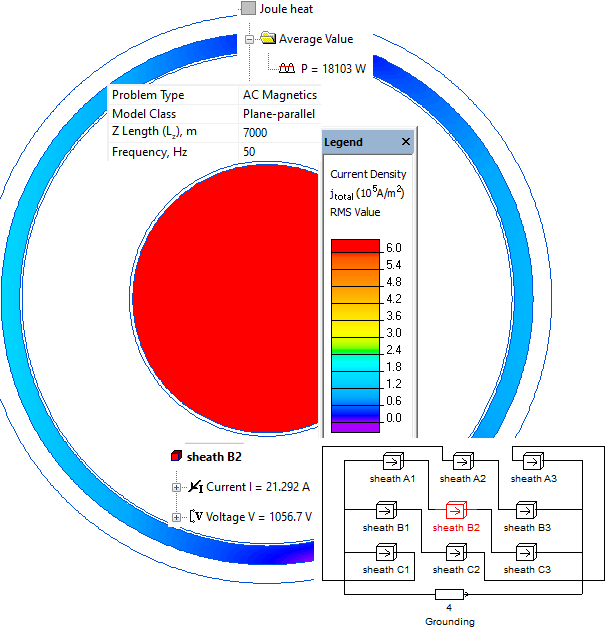Cross bonded cable
QuickField simulation example
Cable sheaths are grounded on both ends to protect personnel from electrical hazards. This may cause excessive circulating sheath currents. To reduce the sheath current we utilize the cross-bonding.
The total length of the cable transmission line is 21 km. The cables are laid in flat formation. There are two link boxes placed at 7 km and 14 km from the beginning.
Problem Type
Plane-parallel problem of AC magnetics.
Geometry
Cable length is 21 km
Given
The continuous rated current is 1550 A (r.m.s.), frequency 50 Hz
Lead electrical resistivity ρ20 = 220 μOhm*mm, temperature coefficient 0.00390 per K.
Grounding resistance is 4 Ohm.
Task
Calculate the currents in the sheath.
Solution
The Milliken conductor is transposed, so we consider that the current density is uniformly distributed across its cross section. We specify the total current and assign zero conductivity to the conductor, so eddy currents are not calculated in the conductor.
Electrical resistivity of metals depends on the temperature ρ = ρ20 · [ 1 + α20 · (θ - 20) ]
We do not calculate sheath temperatures in this example, and take them from Underground cable temperature example. In QuickField we specify electrical conductivity, that is reciprocal to resistivity: σ = 1/ρ
| ρ20, μOhm*mm | Temperature, °C | ρ,μOhm*mm | σ, MS/m | |
|---|---|---|---|---|
| Central cable sheath | 220 | 66.2 | 260 | 3.84 |
| Side cable sheath | 61.7 | 256 | 3.90 |
Results
The sheath current is 21.3 A. The central cable sheath losses are 18103 W per 7 km = 2.6 W/m.

- Video: Cross bonded cable. Watch on YouTube
- Download simulation files (files may be viewed using any QuickField Edition).